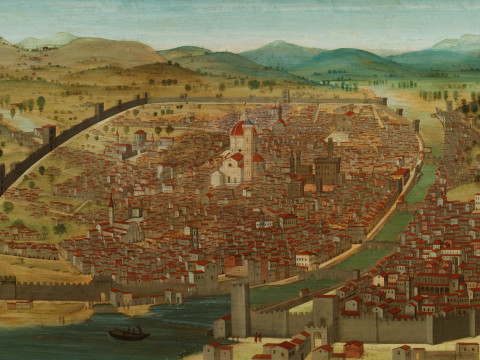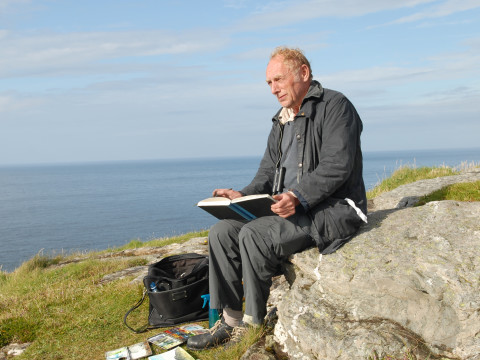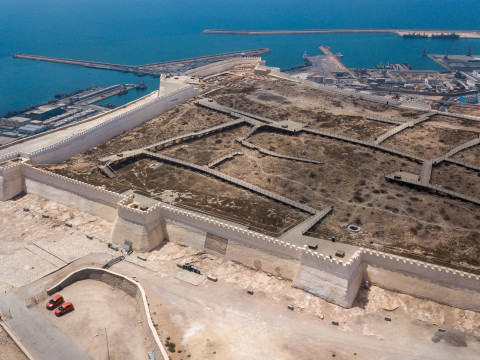
Cézanne and his love affair with the rocks of Provence
By Ann Dumas
Published on 14 July 2020
Curator Ann Dumas digs into how Paul Cézanne’s Provençal landscapes broke new ground with their blend of art and geology.
Ann Dumas is a curator at the Royal Academy. Her RA shows include ‘Picasso and Paper’, and ‘The Real Van Gogh’.
From the Summer 2020 issue of RA Magazine, issued quarterly to Friends of the RA. The exhibition 'Cézanne: The Rock and Quarry Paintings', organised by Princeton University Art Museum in association with the Royal Academy of Arts, was due to open at the RA in July but has sadly been cancelled due to the coronavirus crisis. The exhibition catalogue is available from the RA Shop online.
Born in the stately old town of Aix-en-Provence in 1839, Cézanne was always passionately engaged with his native land. Its ochre, russet and green terrain, punctuated by rock escarpments, caves and boulders, would inspire his work throughout his life. Cézanne painted around two dozen canvases and a number of watercolours of sites noted for their rocky terrain. These often close-focus paintings of rock formations register his profound sense of place and embody his principal preoccupations, both formal and intellectual. They are, moreover, works of astounding beauty, filled with a slow, meditative, quiet spirit. Yet despite the huge amount of scholarship on the artist, these works have never been examined as a focused subject, until now.
The exhibition Cézanne: The Rock and Quarry Paintings opened at the Princeton University Art Museum in the US on 7 March. The show and its accompanying book were the result of long study by the distinguished scholar and curator John Elderfield, as well as Faya Causey of the National Gallery of Art, Washington DC. The exhibition was due to travel in July to the Royal Academy, where I was to oversee its installation. But the Princeton show was forced to close after a week because of the coronavirus pandemic. At the time of going to Press, the exhibition at the RA had been cancelled. But the painter’s fascination with rocks, evident from the beginning of his career, is a story worth sharing in print here, at a time when we all long to travel to the landscapes in which Cézanne worked.
In order to paint a landscape well, I first need to discover its geological foundations.
Paul Cézanne to Joachim Gasquet, c.1897
What we now know is that it was not just the pictorial appeal of rocky sites that attracted Cézanne, but a strong interest in geology, the "new science" as it was called in the 19th century. An enthusiasm for geology, like natural history and astronomy, was part of that fervent quest for knowledge that fuelled not only the period’s scientists but also the more humble pastimes pursued by numerous amateur groups and societies. Collecting fossils was a fashionable hobby mid-century and articles on geology appeared frequently in the popular Press, in magazines such as Le Magasin pittoresque, to which Cézanne’s mother subscribed. But the primary influence on Cézanne’s interest in the subject was Antoine-Fortuné Marion who, along with the future novelist Emile Zola, was one of Cézanne’s brilliant friends at the Collège Bourbon in Aix. Marion, who would go on to become a renowned geologist, palaeontologist and Director of the Museum of Natural History in Marseilles, was among the first scientists in France to promote the evolutionist theories of Darwin’s On The Origin of Species (1859, first published in French in 1862).
Marion and Cézanne’s companionship and their shared interest in geology is demonstrated by the fossils and geological strata that Marion drew on pages of one of Cézanne’s earliest surviving sketchbooks, dating from around 1865–67, when the artist was in his twenties. Expertly analysed by Faya Causey, the pages show Marion’s schematic drawings overlying or incongruously mingled with Cézanne’s random figure studies. A trilobite fossil floats between Cézanne’s sketch of a man playing a tambourine and a genuflecting figure, while elsewhere on the page Marion’s simple outline of a mountain and a diagram of the strata of a limestone formation most likely refer to the Montagne Sainte-Victoire that dominated the Aix countryside. Describing his typical day, Marion wrote to a friend that he practised geology in the mornings but in the evenings was “at Paul’s”. One pictures the two friends seated at a table as Marion expounded his theories about the geological structures of their native land, poring over the diagrams he had jotted down in the nearest thing to hand, Cézanne’s sketchbook.
Marion was a keen amateur artist who accompanied Cézanne on painting expeditions, while Cézanne, who excelled in scientific subjects at school, must have avidly followed his friend’s researches – one likes to think that Cézanne went along on Marion’s hunts for fossils and other geological finds. Cézanne’s letters to Zola, who was in Paris, record idyllic excursions with friends, rambles into the countryside around Aix, climbing, swimming, reciting classical verse on the banks of the River Arc.
Still strewn with relics of Ancient Greek and Roman settlements, Provence was then poetically recast as a modern Mediterranean Arcadia, and the legitimate heir to classical culture. It was also celebrated for its store of prehistoric monoliths and megalithic structures, viewed as repositories of magical forces. This notion of an ancient, privileged land enriched by classical associations was part of a wider movement of Provençal regionalism that took pride in local culture, literature and history, and in which Cézanne and his friends in the Aixois circle were impassioned participants. The painter’s predisposition to classical culture and his commitment to art as a vehicle of deep personal expression have a foundation in these associations, as does the way rocks in his paintings seem almost like abandoned fragments of ancient constructions.

Cézanne had received some tuition in painting and life drawing at the local art school in Aix, but Paris was the destination for any young artist wishing to acquaint himself with the latest developments in avant-garde art. Arriving there in 1861, he enrolled at the Académie Suisse, a studio that offered informal training but also encouraged outdoor sketching. More important were the connections he made with Camille Pissarro, Auguste Renoir and Alfred Sisley, who would become founder members of the Impressionist group. From time to time, he would join in heated discussions about art with the Impressionists gathered at the Café Guerbois in Montmartre. Pissarro recalled Cézanne’s Provençal accent, his uncouth manners and his peculiar art. The older artist, a patriarchal, generous figure, took Cézanne out to paint in the countryside near Pontoise and Auvers in the valley of the Oise. The effect of Pissarro’s instruction on Cézanne’s art was transformative, freeing him from his youthful, imaginary and often violent subjects in dark paint slapped on with a palette knife. Under Pissarro’s kindly supervision, he gained the confidence to look outside of himself, to embrace nature, light and atmosphere and to develop a measured style.
Cézanne learned important lessons from the Impressionists, particularly from their technique of using small, separate strokes of the brush. But he never fell completely under their spell. He was never seduced by Impressionism’s flickering brushwork or fleeting atmospheric effects. His paintings were always distinctive, displaying that innate sense of structure that would become the hallmark of his mature art. As he once famously remarked, his intention was to “redo Poussin after nature”. Each of his regular, parallel brush marks (often referred to as his “constructive strokes”) has the weight of masonry, building blocks with which to construct a dense pictorial surface through carefully orchestrated patches of colour.
Cézanne exhibited in the first three of the Impressionist group’s exhibitions, in 1874, 1876 and 1877, but discouraged by ridicule in the Press, as well as rejection at the official Salon, he retreated to Aix and never exhibited with the group again. From then on he would move between Aix and Paris, although in the last decade of his life he mostly spent his time in the south. After the disappointments of Paris, Cézanne explored the beauties of Provence.

The village of L’Estaque, just to the west of Marseilles, with its bay encircled by ancient rocks, yielded a number of motifs that Cézanne explored in the early 1880s. In some of these paintings his focus is the drama of the craggy and folded rock face that rises up vertically as a backdrop to the village. But in others it is the harmonious panorama of rocks, trees, terracotta roofs, sky and deep blue water of the bay, bathed in the even warmth of the Mediterranean light, that engages him (Rocks, Pines and Sea at L’Estaque, 1883–85).
L’Estaque is one of the four geological sites in Provence that Cézanne had known intimately since childhood and that are the subject of his later rock paintings. The others were just outside Aix – the abandoned quarry of Bibémus and the grounds of a 19th-century manor house, the Château Noir – and the Montagne Sainte-Victoire that dominated the countryside for miles around. An exception to these southern sites was the Forest of Fontainebleau, around 40 miles south-east of Paris, where he had painted in the 1860s and to which he returned frequently in the 1890s right up to around 1905, a year before his death. Fontainebleau had attracted artists of earlier generations, particularly the so-called Barbizon School who preceded the Impressionists as pioneers of outdoor painting.
It is not surprising that Cézanne was drawn to the forest’s huge boulders that contrasted so poetically with the slender trunks of the pines rising above them, a feature he emphasises in his paintings. In Rocks in the Forest (1890s), thin, silvery and violet washes of diluted oil evoke the tumble of sandstone boulders, the light filtering through the web of branches in this silent forest glade. The cool light is that of northern France and there is little doubt that the subject is Fontainebleau, but in some of the rock paintings the precise locale is less clear. As the art historian Philip Conisbee observed, there was “clearly an affinity” between Fontainebleau and Provence in the mind of Cézanne. Perhaps Cézanne sought ambiguity. For an artist whose aims and methods were complex, exactitude was not truth.

Bibémus Quarry, 1895-1900

Cistern in the Park of Château Noir, c. 1900

Trees and Rocks, Near the Château Noir, 1900-1906
The later landscapes that Cézanne created from the 1890s onwards display a new majesty and gravitas. The Bibémus quarry sits on a high plateau two-and-a-half miles east of Aix. It was first excavated by the Romans but supposedly acquired the name Bibémus (Latin for “let’s drink”) when hunters in medieval times used it as a picnic spot. In the 17th and 18th centuries it was actively mined to produce the stone for the splendid mansions that line Aix-en-Provence’s streets today, but by Cézanne’s time it was defunct, the sharp, cut edges and geometric shapes of its stones bearing witness to man’s intervention in the rhythms of nature. The quarry’s distinctive beauty arises from the combination of the rich reddish-orange of the quarried limestone and the vivid green trees. Abandoned, the site had acquired a compelling and mysterious atmosphere embedded in the earth’s deep history, to which Cézanne was profoundly responsive both emotionally and pictorially (Bibémus Quarry, 1895–1900). The rock formations suggest ruined buildings, the remnants of a vanished civilisation, and at the same time, in the words of the art historian Meyer Schapiro, the ‘striving, titanic energies’ of an apocalyptic upheaval disturbing the order of things. These majestic canvases are, for me, the most noble and moving of the late rock paintings, the artist’s profound meditation on man and nature, movement and stillness, permanence and transience and, perhaps, life and death.
The landscapes painted at the Château Noir convey utter solitude. Various myths contributed to the place’s aura of mystery, not least that a previous owner had conducted alchemy experiments in the cellar. In Cézanne’s time the proprietor, who was absent for long periods, allowed him to roam the overgrown grounds and even rented him a room in a small building to store his painting equipment. He found the wooded escarpment at the northern edge of the terrain was especially rich in motifs and we can imagine him scrambling up the stony tracks, brushes in a knapsack, for views of the piled-up rocks interlaced with rich, evergreen vegetation. Rocks above Château Noir (1900-04) is among the most dramatic of all Cézanne’s rock paintings. The close focus and raw immediacy add to its emotional attack. Frenzied, jagged lines outline and crisscross the turbulent chaos of rocks, yet their surfaces are built up through subtle modulations of grey, mauve, ochre and a hint of red, offset by the leaden blue of a stormy sky.

Montagne Sainte Victoire, 1905–6

Rocks Near the Caves above Château Noir, 1895-1900

Trees and Rocks, c. 1895
In the exquisite watercolours that Cézanne made at the Château Noir he explores the rock formations in an entirely different mode. The thinnest veils of soft colour float across white paper in ethereal compositions, a world away from the dense and robust facture of the oils (Rocks Near the Caves above Château Noir, 1895–1900). The watercolours should not be seen as studies for the paintings but parallel, independent works that occupy a more reticent visual and spiritual register. Often Cézanne combines watercolour with pencil, sometimes as under-drawing but often to reinforce the watercolour contours – mark-making that is both assured and tentative. Focusing closely on rocks without the surrounding landscapes, these works come close to abstraction, enhanced by the paper left bare that allows the forms to exist in a self-determined space.
In Cézanne’s final years, the great limestone mass of Montagne Sainte-Victoire was his principal subject (Mont Sainte-Victoire, 1902-06). Leaving behind the earthbound, sequestered forest interiors of Fontainebleau and the Château Noir, and the deep spaces of Bibémus, he embraced the light-filled panorama that stretched before him as he painted on the terrace of his studio at Les Lauves, on the outskirts of Aix. Floating patches of paint – ochre and green – evoke rather than describe rocks and trees in a landscape that rolls away like the sea. On the horizon, the majestic mountain soars, weightless, into the blue-violet sky, reaching beyond the here-and-now to the infinite.
Cézanne’s rock paintings have been seen as an aspect of his landscape painting in general, a less clearly defined body of work than, say his still-lifes or portraits. As an artist for whom the structure of his compositions was fundamental, it is not surprising that he should engage profoundly with the geological structure of landscape itself. These works bring together many of his most enduring philosophical and pictorial concerns: a sense of timelessness, the transience of nature as well as its permanence, the rendering of space, and the equivocal relationship between surface and depth that would so influence the development of modern art in the early 20th century.

Enjoyed this article?
As well as free entry to all of our exhibitions, Friends of the RA enjoy one of Britain’s most respected art magazines, delivered directly to your door. Why not join the club?
Related articles

A love letter to the gallery gift shop
18 November 2024

Painting the town: Florence in 1504
15 November 2024

Moving a masterpiece
7 November 2024

In memoriam: Norman Ackroyd RA
20 September 2024

5 of the best uses of colour in art and culture
18 September 2024
